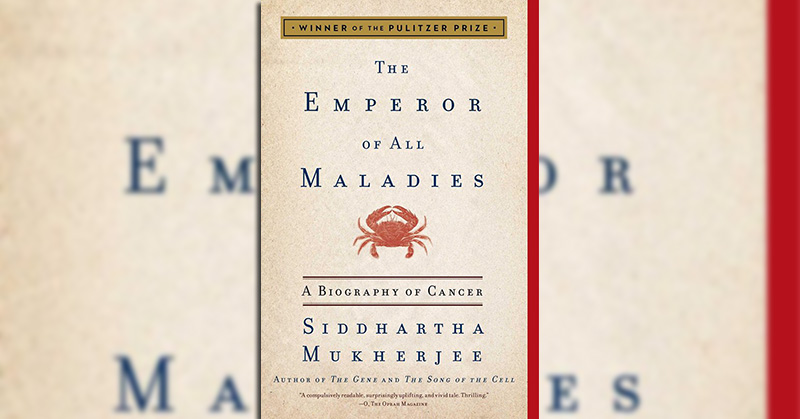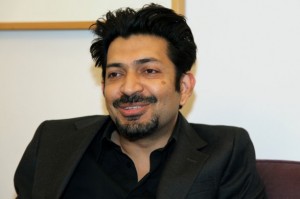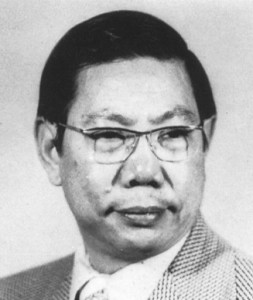De arts en leukemie-onderzoeker Siddhartha Mukherjee (40, foto), van het kankercentrum van Columbia University, schreef The Emperor of all Maladies: A Biography of Cancer (Scribner 2010). Het is een heel goed en lezenswaardig boek.
door Jan Willem Nienhuys (20/01/2011)
OP bijna 500 pagina’s (exclusief voorwoord, noten, literatuur en index) beschrijft hij de ontwikkeling van de behandeling van kanker. Dat is niet alleen chirurgie, maar ook bestraling en chemotherapie. Verhalen over patiënten in het verleden wisselen af met ervaringen met patiënten die hij zelf behandeld heeft. Niet alleen behandeling komt aan de orde, maar ook onderzoek naar het wezen van kanker. Mukherjee maakt de lezer duidelijk hoe recent het inzicht eigenlijk is dat kanker een ziekte is van het DNA. Het gaat meestal niet om een enkele beschadiging maar om een serie mutaties die gezamenlijk veroorzaken dat een cel van het lichaam zich alsmaar begint te delen, dat de remmen op dit proces worden uitgeschakeld, ook de noodrem (zelfvernietiging van de cel), en dat de cellen onsterfelijk worden en verder dat het gezwel zichzelf voorziet van bloedvaten en aan de wandel gaat. Maar dat zijn allemaal beschadigingen van zeer belangrijke genen, zo is het uitzaaien van kanker het gevolg van een corruptie van een gen dat normaal gesproken immuuncellen hun beweeglijkheid geeft.
Ook vertelt hij over de manier waarop in de VS de strijd tegen kanker werd georganiseerd door bijvoorbeeld Mary Lasker, die vanaf ongeveer 1945 de American Cancer Society omvormde van een bedaagde oudeherenclub tot een dynamische fondsenmagneet die een Manhattanplan voor kanker eiste. We horen van de National Cancer Act (VS) van 1971 en de Oorlog tegen Kanker (die gestart werd zonder duidelijk begrip van wat kanker is, en met aanzienlijk minder geld dan echte oorlogen, maar wel met de hoop op een snelle victorie) en nog veel meer.
Het boek groeide uit een vraag van een kankerpatiënte (2005) naar goede voorlichting. Mukherjee realiseerde dat er eigenlijk geen goed boek over dat onderwerp bestond, dus schreef hij het zelf maar. Zoals hij zegt: ‘I wrote the book, because it wasn’t there.’
Als men kijkt naar wat er op het gebied van alternatieve kankergenezerij te vinden is, dan ziet men met de kennis van dit boek al gauw waarom verreweg het meeste op dit gebied onzin is. Kanker is ontspoord DNA, dus therapieën die berusten op het idee dat het door psychologische oorzaken komt, of te veel of te weinig van deze of gene stof, die kan men meteen vergeten. Kankercellen hebben geen speciale oppervlaktekenmerken waardoor het immuunsysteem ze als vreemd en vijandig kan aanmerken. Kanker is ook niet één enkele ziekte (er kan heel veel fout gaan met het DNA), en dat er één enkel middel kan zijn is een fictie. Als men zich realiseert hoe intens er op allerlei manieren gezocht wordt naar middelen tegen kanker, en hoeveel werk het is voor een veelbelovend idee tot duidelijke resultaten leidt, gelooft men niet zo makkelijk in wonderdoeners die aan komen zetten met een of ander plantje of eenvoudig recept met simpele stofjes. En als men ziet hoe lang sommige onwerkzame therapieën van goedbedoelende artsen in zwang blijven door een schijn van werkzaamheid, die hoeft zich geen illusies te maken over wonderverhalen van amateurgenezers.
Chemotherapie heeft een slechte naam vanwege de bijwerkingen, maar de nieuwere middelen worden gemaakt op basis van inzicht in hoe de kankercel functioneert. De cel is namelijk op een heel bepaalde manier ontspoord. Het beschadigde DNA maakt vaak foute enzymen aan, en die enzymen kan men platleggen door het vervaardigen van chemische sleutels die alleen op zo’n fout enzym passen. Waar de oudere chemotherapeutica domweg alle celdeling blokkeerden, werken de nieuwe middelen veel gerichter.
Dit boek vertelt het verhaal van de strijd tegen kanker vooral gezien vanuit Amerika. Eén aspect dat ik gemist heb is de rol van reparatie-enzymen. Onder normale omstandigheden gaat er in elke lichaamscel ongeveer 20 maal per seconde iets kapot in het DNA. Dat wordt bijna allemaal gerepareerd op diverse manieren. Als er teveel kapot gaat (door chemische reacties al dan niet veroorzaakt door ioniserende stralen) kan de reparatie het niet meer bijhouden, maar als het stukje DNA dat codeert voor reparatie-enzymen zelf kapot gaat, dan gaat het natuurlijk mis met repareren. Daar zou ik graag meer over gelezen hebben. Erfelijke vormen van kanker hangen ermee samen. Veel is er niet over bekend, zie verder: DNA repair genes and cancer, en idem deel twee.
Het boek verschijnt op 9 februari 2011 in Nederlandse vertaling, maar de Engelse softcovereditie is spotgoedkoop (16,95 euro) voor een boek van die omvang.
Op internet zijn diverse interviews met Mukherjee te vinden, bijvoorbeeld:
Met Charlie Rose (24 november 2010) (dode link)
Met Jim Glassman (23 december 2010, met transcript) (Noot: het transcript heb ik als laatste reactie hieronder toegevoegd, omdat de video langzaam laadt.)
Op sidmukherjee.com zijn korte vignetten te vinden van alle betrokken personen. Op de rest van die website ook een tijdlijn, links naar recensies en dergelijke.
Ik geef hieronder een korte min of meer chronologische lijst van belangrijke gebeurtenissen in de geschiedenis van kanker, met nadruk op resultaten van wetenschappelijk onderzoek. Het staat bijna allemaal en veel uitvoeriger in het boek.
2625 v.C.: Beschrijvingen van kanker komen op een Egyptisch papyrus voor. Omdat kanker voornamelijk bij ouderen voorkomt, werd deze ziekte pas in de 20ste eeuw een belangrijke doodsoorzaak. Volgens Galenus was de oorzaak ‘zwarte gal’, maar pas aan het eind van de 18de eeuw werd de zwarte gal naar het rijk der fabelen verwezen.
1845-1847: Eerste beschrijving van leukemie door Bennet en later Virchow.
1846: Operatief verwijderen van tumoren neemt pas een vlucht na de ontdekking van de anesthesie. Asepsis volgt in 1865 (Lister).
1891: William Halsted (1852-1922) ontwikkelde tot aan 1907 een uiterst radicale borstamputatie als behandeling van borstkanker. Maar tegen uitzaaiingen hielp die niet. In 1898 bleken er van de 76 patiëntes na drie jaar nog maar 40 in leven. Halsted ontdekte (1907) dat het succes van de operatie er sterk van afhing of de lymfeklieren al waren aangetast of niet.
28 december 1895: publicatie van Röntgen over een nieuw soort stralen; al op 29 maart 1896 werden ze toegepast door Emil Grubbe om kanker door bestraling te vernietigen.
1946: Gilman en Goodman publiceren hun onderzoek (1942) van het effect van intraveneus toegediend stikstofmosterd (chloormethine) op lymfeklierkanker: duidelijke maar zeer tijdelijke remissies. Waarom stikstofmosterd? Men had al in de Eerste Wereldoorlog opgemerkt dat mosterdgas bij de overlevenden het beenmerg aangetast had.
1947: Sidney Farber (1903-1973) uit Boston probeert de stof aminopterine tegen kinderleukemie. Dat was geen wilde gok. Aminopterine had tegenovergestelde effecten aan het vrijwel identieke foliumzuur dat de vorming van bloedcellen juist bevordert. Later werd ontdekt dat het de plaats van foliumzuur in beslag neemt zonder de functie ervan uit te voeren. De stof werkte in maar 20% van de gevallen, en gaf dan hooguit enkele maanden uitstel. Maar de twaalfjarige Einar Gustafson, bij het grote publiek bekend als ‘Jimmy’, geneest in de kliniek van Farber blijvend van zijn lymfeklierkanker, een kankersoort die toen in 90% van de gevallen fataal verliep. Later wordt aminopterine vervangen door amethopterine (later methotrexaat genoemd).
1951: Gertrude Elion ontdekt 6-mercaptopurine (MP-6), een stof die blijkt te werken tegen leukemie, al is het maar voor kort.
1952: George Papanicolau is al heel lang bezig met cervixuitstrijkjes te bestuderen. Baarmoederhalskanker begint niet ineens. De cellen doorlopen verschillende herkenbare stadia voor ze echte kankercellen worden. Een proef begint om te zien of men door uitstrijkjes te bekijken de kanker voor kan zijn. De proef is een groot succes, en later komt ook de mammografie op.
1953: Crick en Watson publiceren de structuur van DNA. Later zal blijken dat kanker in wezen komt door een beschadiging van het DNA, waardoor het DNA niet de goede stoffen aanmaakt. Hier gaat natuurlijk een hele geschiedenis van genetica sinds Mendel aan vooraf.
1954-1964: Onder auspiciën van het Cancer Chemotherapy National Service Center (CCNSC) worden in tien jaar tijd ruim 200.000 stoffen uitgetest op in totaal 20 miljoen muizen om zo middelen tegen kanker te vinden.
1955: het giftige antibioticum actinomycine D blijkt effectief te zijn tegen uitzaaiingen van Wilmstumor (een soort nierkanker). In 1958 blijkt dat de combinatie met röntgenbestraling nog beter werkt. Omstreeks 1955 begint men systematisch met gerandomiseerde klinische onderzoeken met placebocontroles. Omdat ook kanker resistent wordt, onderzoekt men combinaties van chemotherapeutica.
1956: De Chinese arts Min Chiu Li (foto van sidmukherjee.com) behandelt uitgezaaid choriocarcinoom (placentakanker) met methotrexaat. Nadat de kanker ‘verdwenen’ was, zag hij aan de aanwezigheid van HCG (dat door die kankercellen wordt geproduceerd) dat er nog zulke cellen moesten zijn, en ging door met zware chemotherapie tot er geen HCG meer in het bloed van de zieken te vinden was. Hij werd ontslagen wegens het nodeloos doorgaan met therapie. Dat is tegen de regels, en regels gaan natuurlijk voor. Maar Li’s patiënten werden niet opnieuw ziek, in tegenstelling tot degenen bij wie minder lang was doorgegaan.
1956: In hetzelfde jaar begint Henry Kaplan lymfeklierkanker (de ziekte van Hodgkin) met heel precies gerichte intense röntgenstralen te behandelen. Eveneens in dat jaar herontdekken Richard Doll en Bradford Hill (VK) en Ernst Wynder en Evarts Graham (VS) de veruit belangrijkste oorzaak van kanker: roken. (Mukherjee vermeldt niet dat de Duitse artsen Müller (1939) en Schairer en Schöniger (1943) het verband tussen roken en longkanker al veel eerder hadden vastgesteld; zie het artikel van Proctor en de Duitse Wikipedia.) Dat was het begin van een lange harde strijd tegen Big Tobacco. Andere omgevingsfactoren kunnen ook kanker veroorzaken, vaak via het beginsel dat chronische ontsteking (door contact met asbestvezels, of door maagbacteriën, of door hepatitis B) uiteindelijk kanker veroorzaakt. Maar tabak is nog steeds de ernstigste oorzaak van kanker (en andere ziekten van longen en bloedvaten), en een overheid die het roken zou kunnen uitbannen zou een enorme stap voorwaarts doen in de strijd tegen kanker.
1958: In Afrika ten zuiden van de Sahara blijkt het virus (EBV) dat de ziekte van Pfeiffer veroorzaakt, medeschuldig te zijn aan een vorm van lymfeklierkanker (Burkittlymfoom), hoogstwaarschijnlijk in combinatie met iets anders zoals malaria. Immers, ongeveer 80 procent van de westerse mensen maakt een infectie met EBV door. De eerste ontdekker van een kankervirus (Peyton Rous) krijgt 55 jaar na dato een Nobelprijs in 1966. Maar het idee dat kanker door virussen wordt veroorzaakt, blijkt een doodlopende weg. De virussen blijken bij nader inzien ontsnapte oncogenen te bevatten.
1960: Vincristine uit de roze maagdenpalm (uit Madagaskar) wordt ontdekt. Het werkt speciaal tegen leukemie door de spoel van microtubuli te saboteren die bij celdeling de chromosomen uit elkaar trekt.
1961: Proeven beginnen met een combinatietherapie met vincristine, amethopterine, MP-6 en prednison: VAMP. De therapie beloofde eerst duurzame genezing van kinderleukemie, maar in veel gevallen bleken er ook in de hersenen kankercellen terecht te zijn gekomen. Wegens de bloed-breinbarrière konden de chemotherapeutica die niet bereiken en gingen de kinderen een paar jaar later toch dood. De therapie werd uitgebreid met bestraling van de hersenen en injectie van methotrexaat in het hersenvocht, alles bij elkaar een vreselijke therapie. Maar in 1979 bleek dat 80% van de kinderen echt genezen werden.
1962: De ontdekking van paclitaxel (Taxol) begint met de waarneming dat een extract uit de bast van een bepaalde taxussoort tumoren bij muizen remt. Vijf jaar later is de actieve stof geïsoleerd, en gaat men op zoek naar een manier om die op een efficiënte manier te maken. Meer over de geschiedenis van Taxol in Wikipedia (in het boek wordt het maar even genoemd).
1967: Er zijn al lang twijfels aan het nut van de radicale operatie van Halsted, en een vergelijkend onderzoek tussen de ‘ouderwetse’ radicale operatie voor borstkanker en minder ingrijpende procedures al dan niet in combinatie met bestraling gaat van start. In 1981 blijkt dat de erg verminkende radicale mastectomie geen meerwaarde had in termen van overleving en uitzaaaiing. Negentig jaar lang was een overmatig zware therapie toegepast, eenvoudigweg omdat niemand eerder op het idee gekomen was na te gaan of het ook een beetje minder kon.
1968: Sommige vormen van borstkanker blijken gevoelig te zijn voor oestrogeen. Daar gaan ze harder van groeien. Maar tamoxifen (gepatenteerd in 1962) blijkt aan de oestrogeenreceptor van zulke kanker te binden, zonder die te activeren. Daardoor stoppen die kankercellen met groeien en verschrompelen ze zelfs.
1970: Ontdekking van retrovirussen door David Baltimore en Howard Temin; het Rous Sarcoma Virus is zo’n virus (veroorzaakt kanker bij kippen).
1973: Proeven beginnen in Milaan om te zien of operatie plus chemotherapie beter is dan alleen operatie, in geval van borstkanker in een vroeg stadium. In 1975 is al duidelijk dat chemotherapie de terugkeer van kanker met ongeveer een derde kon verminderen. De proeven kunnen niet in de VS gedaan worden, omdat daar teveel ruzie is tussen chirurgen en chemotherapeuten. Later (1981) blijkt dat speciaal bij vrouwen boven de vijftig tamoxifen ook een toegevoegde waarde heeft.
1974: Uitgezaaide teelbalkanker blijkt wonderbaarlijk te genezen, mede door gebruik van het nieuwe middel cisplatin. Rond deze tijd zijn er veel nieuwe chemotherapeutische middelen ontwikkeld.
Eind jaren 1970: Ontdekking van de functie van het src-gen. Dit maakt een zogeheten kinase. Dat is een molecuul dat werkt als een schakelaar die tal van functies in de cel kan aanzetten. Als dit kinase defect is (doordat het door een fout gen afkomstig van een virus wordt gemaakt) zet het gewoon alles aan, onder andere celdeling: de proto-oncogentheorie van Varmus en Bishop. Andere oncogenen volgden, bijvoorbeeld ras in 1982. Tegenwoordig zijn er wel honderd van die genen bekend. Sommige zetten normaal de celdeling aan, andere zijn juist remmen op celdeling of zorgen voor zelfmoord van de cel als die niet meer goed werkt. Als zulke genen door mutatie kreupel worden kan een cel veranderen in een tumorcel. Weer andere mutaties maken dat de tumor voorzien wordt van bloedvaten, of dat de cellen kunnen uitzaaien. Er zijn veel van dat soort mutaties nodig voor kanker ontstaat.
1980 en later: De palliatieve zorg, met nadruk op wetenschappelijk verantwoorde pijnstilling en medicijnen tegen misselijkheid (veroorzaakt door chemo) begint op te komen. Speciaal in het VK komen er veel hospices.
1982: Een nieuwe therapie bestaat erin dat het beenmerg van een patiënt wordt afgetapt; daarna krijgt hij of zij zulke zware chemotherapie dat het beenmerg afsterft en de chemotherapie dus zelf geen leukemie kan veroorzaken. Na afloop van de chemo (als de patiënt niet aan een infectie is overleden) wordt het afgetapte beenmerg weer teruggetransplanteerd. De resultaten waren zo veelbelovend dat allerwegen in de VS patiënten van hun verzekeraars eisten dat deze de experimentele therapie zouden vergoeden. In 1993 werden hun rechten zelfs in een wet vastgelegd. Het was bijna onmogelijk om nog deelnemers aan een proef met loting te krijgen. Het enige zeer gunstig verlopen onderzoek uit 1999 (Zuid-Afrika) bleek frauduleus en vier jaar later, toen er eindelijk een definitief fatsoenlijk onderzoek was gedaan, bleek dat deze methode geen enkel voordeel bood. Ondertussen waren er wereldwijd 40.000 vrouwen met borstkanker mee behandeld (kosten circa 100.000 dollar per patiënt).
1986: APL is een zeldzame vorm van leukemie, veroorzaakt door een specifieke mutatie, waardoor de witte bloedlichaampjes niet uitrijpen. Het blijkt dat deze vorm van kanker met retinolzuur (de zure vorm van vitamine A) te behandelen is. De reden: retinolzuur bindt zich aan het foute enzymproduct van het gemuteerde gen. In hetzelfde jaar wordt ontdekt dat sommige soorten borstkanker een overactief (gemuteerd) gen hadden genaamd Her-2. De firma Genentech ontwikkelde in 1988 een Her-2-antilichaam: een stof die zich stevig bindt aan het product van dat gen. Dit antilichaam (Herceptin) had een groot effect op die speciale soorten borstkanker. Aanvankelijk werd Herceptin toegepast bij patiëntes met borstkanker in een gevorderd stadium. Maar in 2003 werden twee onderzoeken gestart die tezamen lieten zien dat meteen toepassen van Herceptin de aantallen die overleefden met een derde deden toenemen.
1998: De firma Novartis heeft Gleevec (imatinib) geproduceerd. Het werkt in de reageerbuis tegen CML, een vorm van leukemie die ‘chronisch’ is, dat wil zeggen pas na drie tot vijf jaar doodt. Het is weer zo’n stof die zich bindt aan een product van een gemuteerd gen. Daar was de stof expliciet op ontwikkeld. Novartis heeft echter geen zin in de uiterst kostbare proeven, want in de hele VS krijgen maar een paar duizend mensen per jaar CML. Dan is een investering van 200 miljoen dollar in proeven om het middel goedgekeurd te laten krijgen wel een grote smak geld. Uiteindelijk stemt men toch toe om het uit te proberen op een honderdtal uitbehandelde patiënten. Het was een enorm succes. Gleevec is het soort wondermiddel waar een oncoloog van droomt: vernietigt de kankercellen en laat gewone cellen ongemoeid. Maar onherroepelijk ontstaan er dan toch cellen die Gleevec-resistent zijn, door een nieuw mutatie van het al gemuteerde gen. Daartegen is weer een nieuw middel ontwikkeld: dasatinib (2005). Inmiddels zijn er al zo’n twee dozijn van dit soort stoffen ontwikkeld.
2000: Weinberg en Hanahan geven een lijst van zes eigenschappen, elk ontstaan door aparte mutaties, die een kankercel kenmerken. In kankercellen zijn meestal tientallen of zelfs meer dan honderd mutaties aanwezig, maar bijvoorbeeld slechts tien die het kankergedrag veroorzaken. Dat het er zoveel zijn, komt onder meer doordat bij de celdeling wel eens wat misgaat en kankercellen delen zich heel vaak. Maar hoe ingewikkeld het uiteindelijk toch is, ziet men afbeelding 2 in het hierboven geciteerde artikel van Weinberg en Hanahan.
Er zijn onderzoekers die denken dat het mogelijk moet zijn alle genfouten op te sporen die betrokken zijn bij kanker, en antistoffen te maken tegen elk ongewenst genproduct. Of dat lukt is de vraag. Kankercellen muteren soms verder tot ze die antistoffen helemaal niet meer binnenlaten. Eerdere grootscheepse plannen zijn ook op niets uitgelopen. James Watson dacht in 1969 dat een ‘oorlog tegen kanker’ een onzinplan was. Maar in 2009 was hij, getuigend voor het Amerikaanse Congres, aanzienlijk optimistischer. In elk geval is de biochemie van de kankercel grotendeels opgehelderd, zei hij.
Oorspronkelijk was dit artikel gepubliceerd op het (oude) Skepsis-blog en bestond de mogelijkheid om daaronder in discussie te gaan, waar geregeld uitvoerig gebruik van werd gemaakt. De discussie onder dit bericht kan de geïnteresseerde teruglezen in deze pdf (30 pagina’s).



